- Benedicte Wrensted ›
- Biography and History
Biography and History
Biography
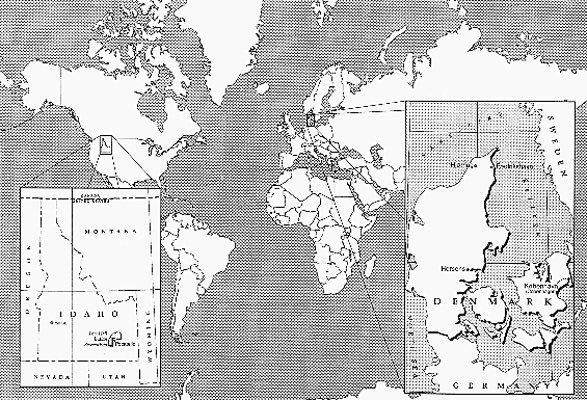
Born February 10, 1859, in Hjørring, Denmark, Benedicte Marie Wrensted grew up and went to school in Frederikshavn. She learned photography from her aunt, Charlotte Borgen, in the 1880s.
Benedicte was a professional photographer in Horsens, Denmark and had a studio there for about four years. Emigrating to the United States with her mother Johanne in July of 1894, she first went to Philadelphia to visit a cousin, then traveled to Pocatello, Idaho where her brother Peter lived.
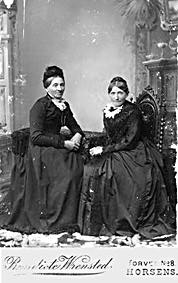
Credit: Scherer Personal Collection.
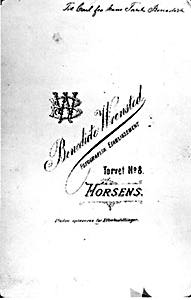
Credit: Scherer Personal Collection.
When she arrived in 1895, there were already several commercial photographers in Pocatello. Wrensted purchased the studio of A. B. Hower in about November of 1895.
Benedicte Wrensted advertised her growing business regularly in The Pocatello Tribune and took portraits of both Euro-Americans and Native Americans. In 1912, at the age of 53, the same year she became a United States citizen, Wrensted ended her career as a photographer. She died in Los Angeles, California in 1949, a month before her ninetieth birthday.

Credit: Byarkivet, Horsens, Denmark
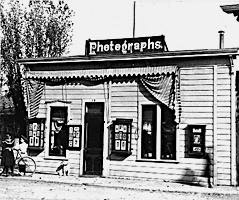
Credit: Scherer Personal Collection.
On May 19, 1905 The Pocatello Tribune reported, "Wrensted Building Moved Out. The photographic gallery of Miss Wrensted is in the street today. It is being moved off the lots where a big new building is going up." The new structure cost $8,000.
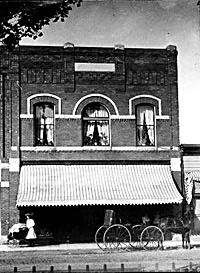
Credit: Scherer Personal Collection.

Credit: Scherer Personal Collection.
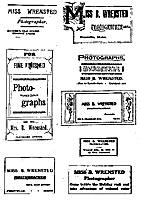
- December 25, 1896
- September 29, 1899
- December 23, 1905
- November 4, 1907 and ran frequently until March 4, 1911.
Credit: Scherer Personal Collection
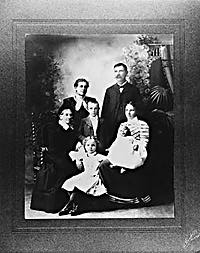
Credit: Scherer Personal Collection.
Pocatello History
There is a reciprocal relationship between a small community and its town photographer. Communities need pictures to document their progress, both economic and cultural: and the photographer's existence depends on the satisfaction of the clientele.
The volunteers arrived at the train station in the morning, and after a "bounteous breakfast" at the pavilion, the "formal ceremonies" began with a procession. The parade passed through a tented arch at the intersection of Cleveland and Center streets. This view is of Cleveland Avenue.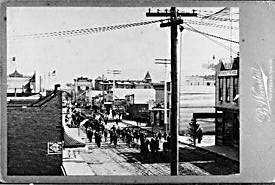
Welcome Home Parade, 1899, for volunteers who fought in the Philippine - American War in 1898. The roster of Company G, First Idaho Volunteers, and an account of the heroes' welcome were printed in The Pocatello Tribune , September 30, 1899.
Colonel J. W. Jones is on horseback, wearing a sash as marshal of the day; he is flanked by M. D. Rice and H. K. Higson. They are followed by the army band, veterans of the Civil War, the mayor and city council in a horse-drawn wagon, and lastly, the Pocatello Fire Department.
Credit: Bannock County Historical Society and Museum

Pocatello fire department, 1896. The men stand in front of the city's first school, city hall, police, and judge's office.
On the ladder, top to bottom: Walter Slater, Fred Cox, Fred Brown, Jimmy Regan, and George Kinport, mascot. On the wagon, left to right: George Brinson, John Steinman, John Tillotson, and Bob Forest. Front row, left to right: William Brinson, Bill Price, George Corbridge, Dan Jacobsen, George Firdell, Dave Kinport, and Henry Peake.
Credit: Bannock County Historical Society and Museum.
Benedicte Wrensted's camera recorded the growth of Pocatello at the turn of the century. Her photos provide glimpses of the changes, as one-story wood buildings gave way to three story brick and stone structures, wooden sidewalks began to line dirt streets, large Victorian houses were built, and telegraph and telephone wires crisscrossed the sky.

This is a typical parlor portrait of the period. The Cook/Leonard/Derr family had ties to the Fort Hall community through Mrs. Cook, whose husband, Mr. A. L. Cook, had been Indian agent from 1882-1885. Photographed 1901. Left to right: George W. Derr, Estelle Potter, Leonard Derr, Elizabeth Potter, Eugene O. Leonard and Sarah Potter Cook (Mrs. A. L. Cook).
Credit: Smithsonian Institution, National Anthropological Archives, Eugene O. Leonard Collection, Photo Lot 92-3.

Residence of Louis William Meyers, 804 So. Cleveland, Pocatello, September 1906.
Captioned by a family member:
Pa stands by his horse and buggy, Golda [Meyers] behind Pa. Ma on the lower porch with Polly on her hand. Ida [Nesbit] and Baby Sadie on the veranda. Little Louis and Helen Nesbit on the veranda and Mr. [Watson] Nesbit standing among the vines in the yard.
Credit: Scherer Personal Collection
Mrs. Derr and Mrs. Cook were sisters. Mrs. Derr wrote E. O. Leonard on January 13, 1901:
Miss Wrensted called here after you were gone, said she could have taken our picture in the front room and would have come if she had thought of it. Told her we would wait until you came home.
Though primarily a studio portrait photographer, Wrensted also took pictures of community events. Every individual in a group photo was a potential customer.
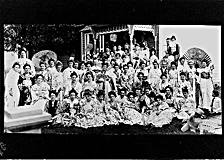 Party at the home of Mrs. Simon Lewis, 63 So. Arthur, 1903. According to The Pocatello Tribune (June 26, 1903) this gathering of "fifty-four guests, the most prominent ladies of Pocatello [as] the Ladies of Japan [was] brilliant entertainment. All the guests had their picture taken in a group."
Party at the home of Mrs. Simon Lewis, 63 So. Arthur, 1903. According to The Pocatello Tribune (June 26, 1903) this gathering of "fifty-four guests, the most prominent ladies of Pocatello [as] the Ladies of Japan [was] brilliant entertainment. All the guests had their picture taken in a group."
Credit: Bannock County Historical Society and Museum
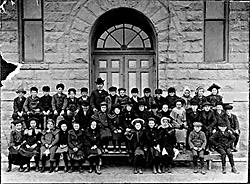
Credit: Bannock County Historical Society and Museum
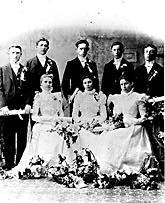
Left to right, standing: Walter D. Service, Charles W. Illingsworth, Thomas R. Jenkins, Albert C. Pearson, and Leo Lewis; seated: Mabel Thomas, Helen C. Forrest, and Essie M. Kinport.
Graduation photos were a mainstay of the local photography studio. This portrait of the "Excelsior Class of '99" from Pocatello High School hung on the left wall of Wrensted's studio.
Credit: Pocatello High School.
Women Photographers/Ella's Dress
Portrait photography was an acceptable profession for nineteenth century women. It was regarded as tedious, painstaking work, suited to a woman's temperament. For all photographers, male as well as female, the technique and skills were mainly self-taught or were acquired under the brief tutelage of other photographers. Women could carry out their photography careers within the confines of their studios, which were often in their homes. This created an aura of domesticity that lent respectability to the profession.
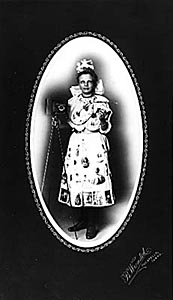
Credit: Scherer Personal Collection.
Because it was a relatively new field, photography was not hampered by cultural and social traditions of long apprenticeships and male domination, as was true in other art related fields. (The Academy of Art in Copenhagen, Denmark, for example, was closed to female artists until 1888.) In Europe and America both, female photographers flourished.
Ella Wrensted was born December 27, 1892. Benedicte taught her photography and Ella began taking pictures on her own as early as age 12 (1904). Thus she became the third generation of women photographers in her family.
Ella worked as an apprentice for Wrensted while she was in high school. In 1913, at the age of 21, she moved with her aunt and her grandmother to California, where she was employed in camera shops. She returned to Pocatello and is listed in the town's 1917 business directory as an assistant to Mrs. W. E. (Mary H. Cole) Garvey, Benedicte Wrensted's successor.
In 1922, Ella moved to Casper, Wyoming, where she bought a photography studio of her own. She worked there until 1924, when, at the age of 32, she married Harry J. Boone and moved back to California. She died June 6, 1986, at the age of 94, after running a photography studio in Bellflower, California for many years.
Of the six visible Native American photographs ringing the bottom of Ella's skirt, four have been identified. See the following four photographs.
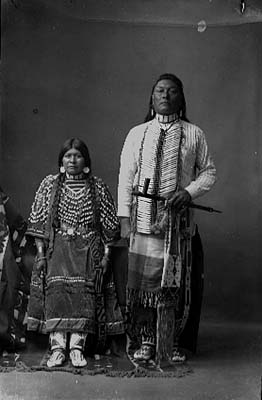
The Gibsons are standing on a trade shawl. He is wearing a long hairpipe breastplate and holds a pipe bag. Susie Gibson's velvet dress is decorated with cowrie shells, metal discs, and ribbon appliqué.
Credit: Idaho Museum of Natural History, Ruffner Colln. 253239.
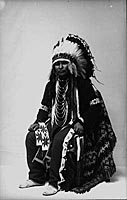
Credit: * National Archives and Records Administration, Still Picture Branch: 75-SEI-140
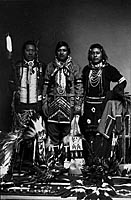
Lamar Pokibro (center; b. 1879 d. 1963) and two unidentified men. Pokibro, a Bannock , wears beaded gauntlet gloves, and a neck scarf, items common among men in the Wrensted portraits. His breechcloth is decorated with ribbon appliqué and metal discs, probably a Southern Plains design.
In the foreground are two feather bustles for the Grass Dance, a long feather headdress, a reservation hat with a beaded hatband and two straps of dance bells. The fur-covered coupstick held by the man on the left was a symbol of warrior status.
Credit: * Idaho Museum of Natural History, Ruffner Collection: 253229

The photograph on the extreme right of Ella Wrensted's skirt is of Minnie Camas Willie (b. 1880 d. 1955). A Weiser-Shoshone from the Boise Valley, she married Captain Willie and reared Lewis Ballard, son of Julia and Johnny Ballard.
Minnie Camas Willie is wearing beaded leggings, a dress decorated with glass bugle beads, a cloth blouse, a beaded and metal-studded belt, metal wrist bands, and shell earrings. Her long necklace is of brass trade beads. The glass plate negative has been cracked over the years, producing lines seen at the top of this print.
Credit: * National Archives and Records Administration, Still Picture Branch: 75-SEI-8
[ TOP ]